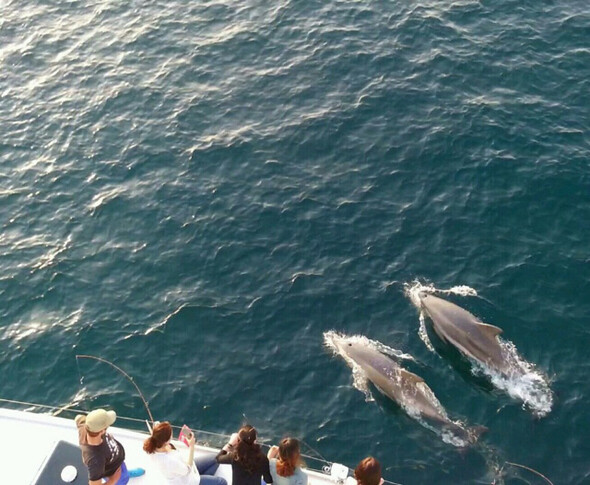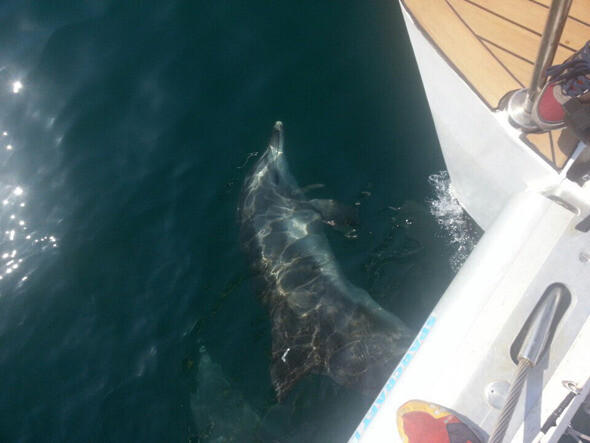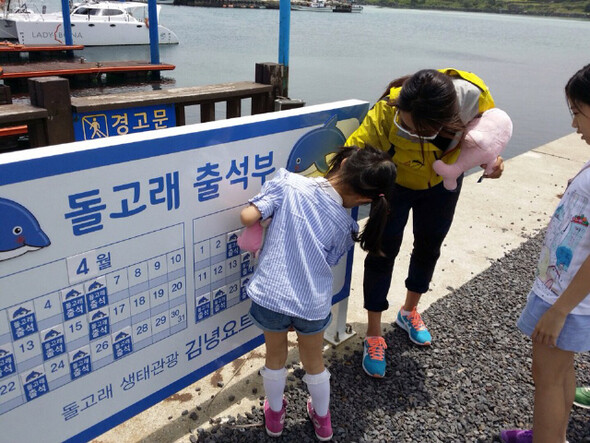hankyoreh
Links to other country sites 다른 나라 사이트 링크
[Reportage] Searching for dolphins off the coast of Jeju Island

By Nam Jong-young, staff reporter in Jeju
The waters off the coast of Jeju City have become established as the best whale-watching spot for seeing the Indo-Pacific Bottlenose Dolphins ‘Jedol.’ Since spring of last year, these dolphins appear once every two or three days and play alongside a whale-watching yacht. If you’re lucky, you might see Chunsam and Sampal along with Jedol. Try taking binoculars with you. You’ll see two dolphins, tagged ‘1’ and ‘2,’ swimming along with all their might.The early summer sun reflected off of the white deck of the yacht. As Gimnyeong Yacht Tours’ 30-passenger yacht Bona drifted beyond the sea wall of Gimnyeong Port, on the northeast coast of Jeju Island, guide Kim Hyun-sun, 25, stood before a group of tourists.
“You can usually see the dolphins around 10 o’clock. They roam off the coast of Jeju Island, and are most often seen off Gimyeong Beach.”
“Will we see them today?”
“Well, since they’re wild animals, I can’t give you any guarantees.”
One tourist, sitting on the deck in a line with other women in their fifties, joked in her Jeolla Province dialect, “Isn’t it that you’ve trained them to come at 10 o’clock?”

That was when the captain yelled, “There’s a dolphin!”
The date was June 18, and the yacht stood off the coast of Gimyeong Beach. A family of six or seven dolphins was swimming along the shoreline. Like children walking in step with each other, a mother dolphin and her baby made their way side-by-side, following the horizon. What looked like a group of at least dozens of dolphins was approaching from the east. The dolphin family splashed towards the swiftly approaching group, and was quickly lost among them.
Soon afterwards, a passenger yelled, “It’s a dolphin tagged with the number ‘1’!” And there was Jedol, with ‘1’ written in white on his dorsal fin. He jumped up into the air, drawing a rainbow-like arc. Chunsam, tagged with the number ‘2,’ also emerged swiftly from the front of the boat. Scientists from the Citizens’ Committee for the Release of Dolphins, who worked to have Jedol and Chunsam released into the wild, once wrote these numbers with dry ice on the dolphins’ dorsal fins to help track them after their release.
Almost a year has passed since these Indo-Pacific Bottlenose Dolphins were released from captivity. Jedol, who previously performed in dolphin shows at Seoul Grand Park in Gwacheon, Gyeonggi Province, and Chunsam and Sampal, who performed at Pacificland in Seogwipo, Jeju Island, have now completely adapted to life in the wild. Today, if you take a boat out off of the coast of Gimyeong, you can see these former show dolphins in their new, natural habitat.
For former show dolphins to have survived for so long in the wild means that they have been able to hunt for themselves-in other words, they have adapted successfully. Jedol, Chunsam, and Sampal have also integrated themselves into a school of dolphins, showing that they have recovered the defining feature of their species: their sociability.
That day in June, Kim Hyun-woo of the Whale Research Center at National Fisheries R&D Institute commented, “Jedol has gained weight. This means that he’s healthier than he was before being released.” Furthermore, Jedol, Chunsam, and Sampal haven’t been following fishing boats around or begging for food from tourists since their release, dissipating the worries that they would retain ‘human friendly habits.’
Kim Kwang-kyung, 47, president of Gimyeong Yacht Tours, said, “These dolphins do seem to enjoy riding atop the wakes that come off of tourist yachts, but not any more so or any more often than other wild dolphins.” Simply put, these three dolphins are now indifferent towards humans. Or rather, they approach only on their own initiative, to play in the wakes as they please.
Jedol, who was illegally captured in May of 2009 in a stationary net off of Shinpoong Village, Seogwipo, performed in dolphin shows three to four times a day at Seoul Grand Park. But Jedol’s performances came to an end with Seoul Metropolitan Government’s decision to rehabilitate and release the show dolphin from captivity. Jedol completed his rehabilitation program by July 18 of the same year and was subsequently released into the waters off of Jeju Island. Chunsam and Sampal, who had been performing shows at Pacificland around the same time, were also recovered through a court decision and released along with Jedol.
The release of the dolphins has presented South Korean society with some unfamiliar challenges. It has given us occasion to consider what an animal’s ‘natural right to life’ entails, and even to consider with interest the living conditions of animals in captivity.
But has anything changed, really, since Jedol’s release into the wild? The number of show dolphins in South Korea has nearly doubled since his release. According to figures from Korean Animal Welfare Association, there are currently 52 dolphins in aquariums nationwide, nearly twice as many as in 2011, the time of the court decision mandating Jedol’s release. This steep increase has been caused by interest from domestic and foreign capital in recent years in creating a South Korean version of “Seaworld,” causing a rush of capital investment in the show dolphin business.
Geoje Sea World, a venture funded by Singaporean capital, and other middle-sized aquariums, such as Hanwha-affiliated Aqua Planet, opened their doors in recent years. Lotte World 2 will soon open a Beluga (Arctic white whale) exhibition. Samsung has revealed plans to construct a massive aquarium in Yongin, Gyeonggi Province to attract tourists from China.
Cho Hee-kyung, president of the Korea Society for Animal Freedom, said, “When dolphin shows become declining attractions in advanced countries that have begun to consider them inhumane, they are often exported to countries that lack animal rights awareness and regulations, like China-and, embarrassingly enough, South Korea. Yes, we are one of those countries that enthusiastically imports these kinds of businesses.”
There are two kinds of trends worldwide in the dolphin industry. The first is the case in which dolphin shows confront strongly voiced opposition from animal rights activists and become declining investments. Of 28 countries in the European Union, 13 don’t have any whale-type exhibitions, while dolphin exhibitions have been illegal in India since last year.
The second trend is best exemplified by the United States where the dolphin show business and whale eco-tourism co-exist, albeit with incredible tension between them. Both dolphins shows in large capital ventures like Seaworld and whale-watching in California and Hawaii remain established as large tourist attractions in the US, but since an incident in 2010 at Seaworld where a killer whale attacked and killed a trainer, the dolphin show business has been confronting a public relations crisis.
There are a few countries, however, that have struck a balance between both ecology and economy. The United Kingdom, for example, has completely shifted the focus of its “dolphin industry” to whale watching. Professor Peter Hughes of the University of Sunderland, in a 2001 article on the whale watching business, observed that the number of aquariums in the United Kingdom reached a peak of 25 in the 1970s, then shrunk to only 6 by the mid-1980s due to pressure from environmentalist groups and increased government regulation.
Aquariums had disappeared altogether by the early 1990s. After the UK’s “Into the Blue” campaign (similar to the case of Jedol’s release) garnered attention nationally in 1991, interest in wild dolphins became widespread, resulting in a whale-watching boom in all coastal areas of the UK, including Cardigan Bay in Wales and Moray Firth, Scotland. Whale watching is now the main source of revenue for Scotland’s tourism industry. Scotland doesn’t boast as high sighting success rates as world-famous whale watching sites, because the dolphins move quickly across a broad area, but nevertheless attracts tourists with its ecological education classes and various other programs.
According to the 2010 “Scotland whale-watching report” by Aberdeen Center for Environmental Sustainability, 52,200 tourists visit the east coast of Scotland every year for two or more days for whale watching. 17,000 of these tourists said that their sole purpose in traveling to this region was to see dolphins. The report approximates that dolphins bring in, for Scotland, about 6.5 million pounds (about 11.2 billion won) in annual revenue.
Could whale watching replace dolphin shows on Jeju Island, as well? Some have made negative predictions due to the low whale sighting success rates around the island. But high sighting success rates are not necessarily essential to a successful whale-watching business. A tourist’s sense of satisfaction comes more from the “process of going whale watching,” that is to say from the experience as a whole.

In fact, the expectation that animals should be available for show wherever and whenever we humans please was only established relatively recently, after the creation of the modern zoo. British cultural critic John Berger defines the zoo as, “a monument to the impossibility of [genuine human-animal] encounters” that radically distorts our vision of the lives of animals by creating a situation in which “you are looking at something that has been rendered absolutely marginal”.
Whale watching, on the other hand, provides us an opportunity to have chance encounters with wild animals. You could see a dolphin, or you could not.
To truly experience wildlife may paradoxically be to experience a lack thereof. For whale watching to take off as an industry anywhere, the tourist must be the first to change his or her mindset. We cannot take lightly the joke that “Koreans are the only tourists who demand a refund after being unable to see one of the Big Five (lion, leopard, rhino, elephant, and Cape buffalo) on an African safari.”
Dolphins have been sighted off the coast of Gimyeong 10 days, 13 days, and 15 days in the months of April, May, and June, respectively. Sometimes they hang around all day long. At other times, they pass through quickly. In a standard whale-watching trip lasting around an hour, the chances of actually seeing one of these creatures become even slimmer.
“Don’t tourists complain when they don’t get to see dolphins?” Kim Kwang-kyung was asked.
Her reply was unexpected.
"Both tourists who were able to see dolphins and tourists who weren‘t able to see them seem to have had equally enjoyable experiences when they leave our yachts. Before the tours, we emphasize that they are wild animals, with an ecological explanation.”
I have been on three whale-watching trips, but have actually seen a whale only once. Yet all three trips, I was full of the same sense of excitement and anticipation. No, you can no longer find Jedol at the zoo. If you want to see Jedol, Jedol must come find you.
Translated by Noh Ga-ram, Hankyoreh English intern
Please direct questions or comments to [english@hani.co.kr]

Editorial・opinion
![[Editorial] Intensifying US-China rivalry means Seoul must address uncertainty with Beijing sooner than later [Editorial] Intensifying US-China rivalry means Seoul must address uncertainty with Beijing sooner than later](https://flexible.img.hani.co.kr/flexible/normal/500/300/imgdb/original/2024/0517/8117159322045222.jpg) [Editorial] Intensifying US-China rivalry means Seoul must address uncertainty with Beijing sooner than later
[Editorial] Intensifying US-China rivalry means Seoul must address uncertainty with Beijing sooner than later![[Column] When ‘fairness’ means hate and violence [Column] When ‘fairness’ means hate and violence](https://flexible.img.hani.co.kr/flexible/normal/500/300/imgdb/original/2024/0516/7417158465908824.jpg) [Column] When ‘fairness’ means hate and violence
[Column] When ‘fairness’ means hate and violence- [Editorial] Yoon must stop abusing authority to shield himself from investigation
- [Column] US troop withdrawal from Korea could be the Acheson Line all over
- [Column] How to win back readers who’ve turned to YouTube for news
- [Column] Welcome to the president’s pity party
- [Editorial] Korea must respond firmly to Japan’s attempt to usurp Line
- [Editorial] Transfers of prosecutors investigating Korea’s first lady send chilling message
- [Column] Will Seoul’s ties with Moscow really recover on their own?
- [Column] Samsung’s ‘lost decade’ and Lee Jae-yong’s mismatched chopsticks
Most viewed articles
- 1[Editorial] Transfers of prosecutors investigating Korea’s first lady send chilling message
- 2[Exclusive] Unearthed memo suggests Gwangju Uprising missing may have been cremated
- 3S. Korea “monitoring developments” after report of secret Chinese police station in Seoul
- 4[Editorial] Intensifying US-China rivalry means Seoul must address uncertainty with Beijing sooner t
- 5Could Korea’s Naver lose control of Line to Japan?
- 6[Column] US troop withdrawal from Korea could be the Acheson Line all over
- 7Korea poised to overtake Taiwan as world’s No. 2 chip producer by 2032
- 8Korea cedes No. 1 spot in overall shipbuilding competitiveness to China
- 9Xi, Putin ‘oppose acts of military intimidation’ against N. Korea by US in joint statement
- 10Korea’s first openly trans athlete hopes to prompt a discussion by competing as herself